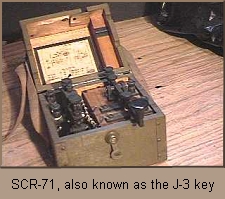 Why
was this so difficult to do in WWII? In great measure it was because back
then most means of military communication in use was based on advances made
in the civilian sector, and many times while these advances proved excellent
they didn’t prove up to the challenges of war. In particular, communication
as it existed at the beginning of WWII fell into two categories: minor
advances in technology and creative advances in the form
of communication available.
Why
was this so difficult to do in WWII? In great measure it was because back
then most means of military communication in use was based on advances made
in the civilian sector, and many times while these advances proved excellent
they didn’t prove up to the challenges of war. In particular, communication
as it existed at the beginning of WWII fell into two categories: minor
advances in technology and creative advances in the form
of communication available.
In terms of the forms of communication
available at the beginning of World War II the military equivalents then
were little different than the nonmilitary varieties used at that time. For
example, the command teletypes used between various Army field headquarters
in Europe were essentially the same as those one would have found on Wall
Street or the Mercantile Exchange in Chicago, to transmit news or stock
exchange ticker data. Even the exciting new “invention” of the
motor-cycle messenger that the Army Signal Corps so effectively
deployed throughout North Africa was little more than the motorized
equivalent of the old hand-carrying Western Union bicycle boy that plied the
streets of New York City. While their use was distinctive, and their
importance beyond question, they were nevertheless nothing more than
motorized forms of civilian mail carriers. And so it was with every other
form of communication then available, from radio broadcasting to control
towers, telephones to teletypes, and even railway semaphores… it was all
little different from that available in
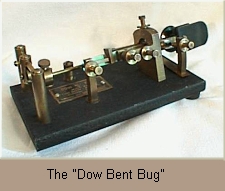 the
civilian world.
the
civilian world.
Which is why the Signal Corps was needed. At the
beginning of WWII the Signal Corps was called on to bring a little
organization to the concept of military communication by finding a way to
not just repurpose what was available in the civilian world but also advance
its development to suit the needs of the armed forces, while at the same
time extending the known capabilities of communication far beyond that
available to include forms and functions unheard of and un-thought of by
either the civilian world or the enemy.
What resulted was an effort to develop better forms of
communication along three main axis: general sensory signaling (typically
signaling that was nonelectrical in nature), electrical signaling (typically
as found and used over wires), and electrical signaling without the use of
wires.
As an aside, the reader should recognize that the
effort the Signal Corps undertook at the beginning of WWII to develop more
effective means of communication in these three areas was a parallel effort.
That is, development in these areas did not take place in a line of
succession but simultaneously across all fronts. The result of this parallel
effort in turn caused the structure of the Signal Corps to need to be
changed… from what it was prior to WWII into what it became during the war,
and in many, many instances even up until today. That is, the operational
form that is seen in the Signal Corps today got its start early in WWII,
with modernization and improvements being made along the way, in response to
the need to develop world class forms of combat communication across the
three areas listed above.
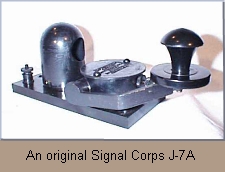 Looking
at each of these in turn, we will classify them as Sensory Signaling (most
usually of a visual or audible type), Wire Based Electrical Signaling, and
Non-wire Based Electrical Signaling.
Looking
at each of these in turn, we will classify them as Sensory Signaling (most
usually of a visual or audible type), Wire Based Electrical Signaling, and
Non-wire Based Electrical Signaling.
Sensory Signaling
Everyone knows by now that back in the Civil War Brevet
Brigadier General Albert J. Myer codified an effective means of semaphore
signaling, called within the Army at the time and even today wigwag
signaling. What few of us today will recall however is that this form of
signaling was still in solid use at the beginning of WWII, even while Samuel
F. B. Morse's telegraph approach to messaging was slowly making its way
throughout the military. The reason wigwag signaling existed simultaneously
with telegraphy was that they both served a purpose, and while in many
instances telegraphy could easily replace wigwag, in others wigwag provided
the only effective means of getting the message through… such as in the case
of two ships at sea in need of passing encrypted, silent messages between
themselves. Even so, as newer forms of tactical combat took the field during
WWII Myer’s systematic wigwag flag based signaling quickly reached its
limits. Morse's approach on the other hand seemed to show no boundaries to
its capabilities, especially if it was coupled with non-electrical
signaling.
 In
the interim though—that is, the interim in time that it would take between
the state of communication at the beginning of WWII and where it needed to
get to if the war was to be won—the Signal Corps had to make do with what it
had. The result was that a whole series of elemental forms of signaling were
used to fill the void between wigwag flags and telegraphy. Among the forms
used to fill the needs of sensory signaling were not just the wigwags and
semaphores, but also pyrotechnics, airplanes reading pieces of colored cloth
spread on the ground (as was done in WWI), and most importantly the old
standby pigeon.
In
the interim though—that is, the interim in time that it would take between
the state of communication at the beginning of WWII and where it needed to
get to if the war was to be won—the Signal Corps had to make do with what it
had. The result was that a whole series of elemental forms of signaling were
used to fill the void between wigwag flags and telegraphy. Among the forms
used to fill the needs of sensory signaling were not just the wigwags and
semaphores, but also pyrotechnics, airplanes reading pieces of colored cloth
spread on the ground (as was done in WWI), and most importantly the old
standby pigeon.
In the early days of WWII pigeons were still a primary
means of signaling and not surprisingly so were sirens and whistles. The
problem with all of this though was that because these were sensory forms of
signaling they all held one or more inherent limitation. So while they had
value as a means of controlling railroad traffic (flags and beacons),
sorting out supplies on a beachhead (wigwag), or passing messages between
ships (blinking lights), they were not invisible to the enemy, were easy to
misread, were of limited capacity, and were often useless during foul
weather. While primitive, they had value, yet no modern war was ever going
to be won with the limitations these forms of communication held. What was
needed instead was fast, reliable, messaging that guaranteed the fewest
mistakes possible. Or put another way, these simple forms of sensory
signaling lacked capacity, speed, and precision. Electrification and the
application of emerging technologies offered a solution to this problem.
Wire Based Electrical Signaling
Considering that telegraphy had already been developed
and deployed in the civilian world by the time of WWII it was only natural
to paint it olive drab and drag it onto the field of combat, along with all
of its cousins, in every form available. Thus Signal Corps troops marched
into the field alongside combat troops, deploying wire based electrical
signaling paraphernalia along the way. Overnight the U.S. military began to
see cables being strung, telegraphs being pounded, telephones being cranked,
and hear teletypes clattering away. So pervasive was this effort that
throughout World War II these forms became the predominant and principal
form of communication the Signal Corps depended on. And while for the most
part they held the field even these did not fill the void or serve the
needs that combat commanders cried for. As a result non-wire based
electrical signaling began to take its rightful place on the battlefield,
and ever since the world of communication—both military and civilian—has
never looked back.
Non-wire Based Electrical Signaling
With rapidity wireless devices
began to leap from theoretical concepts bandied about the halls at Ft.
Monmouth, through design and testing and onto the manufacturing production
lines of companies across America. With the Signal Corps driving
development the time taken to go from concept-to-reality shrunk from the
slow leisurely pace it held before the war to, in many cases, only a few
months. The fact is, the pace of technological development attained by the
Signal Corps from the beginning of WWII up through the last third of the war
was the first practical example of the existence of Moore’s Law, a concept
first explained by Gordon E. Moore (one of the founders of Intel) in 1965...
a time at which WWII was only a distant memory.[1]
Among the inventions that flowed from Signal Corps
supported efforts were the radio, radiotelegraph, radiotelephone,
radio-teletype, television, and RADAR. However, as opposed to how we see
many of them today, their value was not as a means of entertainment but in
their ability to achieve the hallowed goals of capacity, speed and precision
in communication during combat. For example, the accomplishments of radio
transmission in increasing the rate of teletype transmission from the
average Morse Code rate of 30 WPM to an electric teletypewriter rate of over
a hundred words a minute, transmitted reliably and without error, had a huge
impact on the effectiveness of military communication. Even the ability to
predict the impact of weather on combat operations improved because of
Signal Corps' sponsored communication development. In this regard, reporting
the weather locally by radiosonde became the standard. And who can forget
the enormous impact the “handie-talkie” (a term Winston Churchill used to
refer to the SCR-300, a device the rest of us call a walkie-talkie) had on
combat. Something we think of today as an antiquated form of radio
telephony, back when it was first introduced in war the walkie-talkie
brought startling changes to how tactics were carried out.[2]
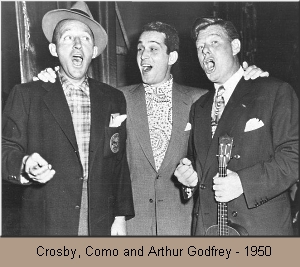 The
astute reader may have noticed our listing of television above, and wondered
about its value during WWII, as obviously the form we see it in today had
not yet come into existence until after the war was over. During World War
II however it made its appearance in another form. Rather than finding a use
in homes so that housewives could see Arthur Godfrey (whose first appearance
on TV was in 1948, when his Arthur Godfrey's Talent Scouts began to be
simultaneously broadcast on radio and television), television found its
first use during WWII as a form of RADAR. One could even say that RADAR was
the crown jewel of communication development during the second world war.
With RADAR the military was able to guide aircraft at a distance, help them
return to base safely, land in inclement weather, and of course detect the
presence of enemy aircraft. It also allowed the military to map land masses
as well as the approach of land while at sea; map storms, guide searchlights
so that antiaircraft guns could hone in on targets, discover ships at sea
and submarines under the sea, guide antiaircraft artillery, and in a revised
form guide torpedoes. And it did all of this with unheard-of precision. On a
technical basis it allowed the development and use of tactics and techniques
that included GCI, GCA, LORAN, SHORAN, RACON, IFF, MEW, ASV, BTO, and RAWIN.
Clearly, back in World War II RADAR was the new black magic.
The
astute reader may have noticed our listing of television above, and wondered
about its value during WWII, as obviously the form we see it in today had
not yet come into existence until after the war was over. During World War
II however it made its appearance in another form. Rather than finding a use
in homes so that housewives could see Arthur Godfrey (whose first appearance
on TV was in 1948, when his Arthur Godfrey's Talent Scouts began to be
simultaneously broadcast on radio and television), television found its
first use during WWII as a form of RADAR. One could even say that RADAR was
the crown jewel of communication development during the second world war.
With RADAR the military was able to guide aircraft at a distance, help them
return to base safely, land in inclement weather, and of course detect the
presence of enemy aircraft. It also allowed the military to map land masses
as well as the approach of land while at sea; map storms, guide searchlights
so that antiaircraft guns could hone in on targets, discover ships at sea
and submarines under the sea, guide antiaircraft artillery, and in a revised
form guide torpedoes. And it did all of this with unheard-of precision. On a
technical basis it allowed the development and use of tactics and techniques
that included GCI, GCA, LORAN, SHORAN, RACON, IFF, MEW, ASV, BTO, and RAWIN.
Clearly, back in World War II RADAR was the new black magic.
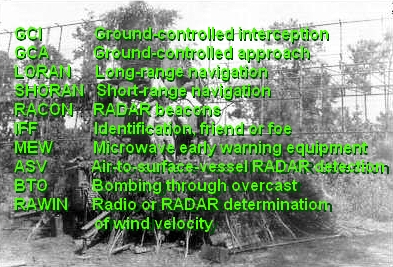 While
many of these forms of “television” were in fact experimented with and
developed in the 1930s, they did not come to the fore as military hardware
and systems until WWII, when they were proven to be desperately needed.
Before WWII much of the experimentation on the technologies that led to
forms of TV communication was done (1917 - 1919) at Camp Vail, in
east-central New Jersey. In 1925 when the name of the camp/fort was changed
to Fort Monmouth, and cost cutting measures forced the Electrical and
Meteorological Laboratories and the Signal Corps Laboratory at the National
Bureau of Standards to be relocated to Ft. Monmouth, and subsequently
renamed the SCL, with a whopping 5 officers, 12 enlisted men, and 53
civilians, things really began to heat up. By the time 1934 rolled around
radio-based target detection was well along in development. With a magnetron
on loan from RCA research progressed to the point that RPF (radio position
finding) became a viable technology. Interestingly, this coincided with the
construction of Squire Hall (1935), a building all who have been stationed
at Ft. Monmouth know well.
While
many of these forms of “television” were in fact experimented with and
developed in the 1930s, they did not come to the fore as military hardware
and systems until WWII, when they were proven to be desperately needed.
Before WWII much of the experimentation on the technologies that led to
forms of TV communication was done (1917 - 1919) at Camp Vail, in
east-central New Jersey. In 1925 when the name of the camp/fort was changed
to Fort Monmouth, and cost cutting measures forced the Electrical and
Meteorological Laboratories and the Signal Corps Laboratory at the National
Bureau of Standards to be relocated to Ft. Monmouth, and subsequently
renamed the SCL, with a whopping 5 officers, 12 enlisted men, and 53
civilians, things really began to heat up. By the time 1934 rolled around
radio-based target detection was well along in development. With a magnetron
on loan from RCA research progressed to the point that RPF (radio position
finding) became a viable technology. Interestingly, this coincided with the
construction of Squire Hall (1935), a building all who have been stationed
at Ft. Monmouth know well.
As RPF moved through its development it advanced from
simple target awareness to microwave usage, Doppler shifted signaling,
bi-static transmission and antenna arrangements, beat detectors, azimuth and
elevation measurement development, use of dipoles on wooden frames as
antennas (see picture behind acronym list above), ring oscillators, antenna
lobe switching, and much, much more. Eventually, by 1938, the first Set
Complete Radio (or Signal Corps Radio, as it is usually but incorrectly
called) was rolled out. This unit, dubbed the SCR-268, was able to aim
searchlights associated with anti-aircraft guns, but little else.
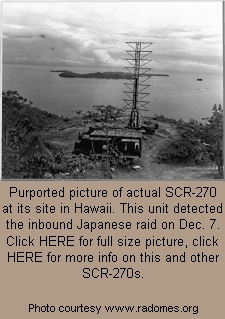 But
that was just the beginning. Once this trick had been mastered it was just a
matter of time before the U.S. Army Signal Corps brought to market the tools
the other combat arms needed during WWII. With rapidity the SCR-268 morphed
into the SCR-270, which, built by Westinghouse, began to make its appearance
at Army bases in 1940. As we all know, an SCR-270 was in full operation near
the island of Oahu on the morning of December 7, 1941. At 0720 its Signal
Corps operators detected and reported a flight of planes heading due north;
and we all know what happened next. By 0759 the Japanese were enjoying a
site seeing tour over a bombed out Pearl Harbor.
But
that was just the beginning. Once this trick had been mastered it was just a
matter of time before the U.S. Army Signal Corps brought to market the tools
the other combat arms needed during WWII. With rapidity the SCR-268 morphed
into the SCR-270, which, built by Westinghouse, began to make its appearance
at Army bases in 1940. As we all know, an SCR-270 was in full operation near
the island of Oahu on the morning of December 7, 1941. At 0720 its Signal
Corps operators detected and reported a flight of planes heading due north;
and we all know what happened next. By 0759 the Japanese were enjoying a
site seeing tour over a bombed out Pearl Harbor.
The 270 was replaced by the 271, which was upgraded to
the 518 which provided radar altimeter data for the Signal Corps'
controlled Air Force. This technology was then expanded to include the
SCS-51 which offered the first viable version of instrument landing
assistance… a concept and technology that the world’s airline industry could
not exist without today. All pause now… thank you U.S. Army Signal Corps for
the modern American airline system! [Editor’s note: the Signal Corps’
development of the ability to land aircraft in bad weather can not in any
way be blamed for today’s trend to strip search you when you want to fly on
one of these aircraft. You will have to blame someone else for that mess.
Try the TSA.)
In 1941 the research labs at Ft. Monmouth were
relocated a few miles south to Camp Evans, in a building known as the
Marconi Hotel (not an actual hotel folks… it was just called that). By
mid-1940 the research being done by the Signal Corps began to be shared with
our British counterparts and this led to even faster technology
development. When the secret stuff the Brits were working on arrived at the
Marconi Hotel development took off almost as fast as one of the new North
American P-51 Mustangs (1940), or perhaps the Bell P-39 Airacobras [1941,
an aircraft sent in mass to the Soviets as part of lend lease… which shows you what the
Signal Corps' new Air Force branch thought of it].
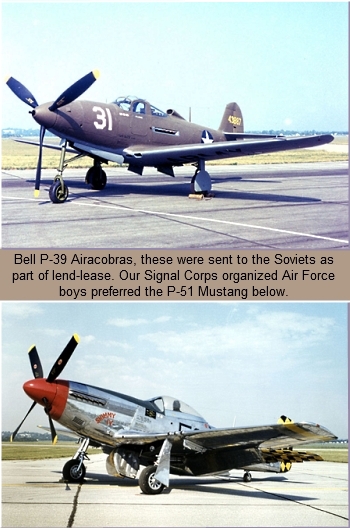 After
the mess at Pearl Harbor the Signal Corps got into true high gear, working
around the clock and at a fevered pitch to develop systems able to protect
the Panama Canal from a similar fate. Microwave was abandoned as the
frequency of choice as frequencies in the 600 MHZ range were tried. Using
four triodes and their associated circuitry, tightly packaged into one glass
envelope, the Signal Corps was able to produce over 240-kW pulse-power at up
to 600 MHz.
After
the mess at Pearl Harbor the Signal Corps got into true high gear, working
around the clock and at a fevered pitch to develop systems able to protect
the Panama Canal from a similar fate. Microwave was abandoned as the
frequency of choice as frequencies in the 600 MHZ range were tried. Using
four triodes and their associated circuitry, tightly packaged into one glass
envelope, the Signal Corps was able to produce over 240-kW pulse-power at up
to 600 MHz.
At about this point in time the numbering system used
to designate communication systems seemed to go awry, at least from where we
sit here in 2012. From the simple SCR 1, 2, 3, 4… etc numbering scheme
things jumped to AN/TPS, TQL, CPS, VCS, and on and on. Regardless,
development progressed and brought to the field the communication systems
needed to achieve the earlier stated goals of capacity, speed, and
precision.
All in all the task of finding a better way of passing
information around the battlefield and back and forth between headquarters
was conquered by the Signal Corps, at first slowly perhaps, but by the time
of Pearl Harbor and after at full speed. As an exercise in corporate
development… development being run and managed by an arm of the U.S.
government, it boggles the imagination as to why this same feat cannot be
accomplished today. With little doubt, today the U.S. government is unable
to match corporate America when it comes to efficiency, low cost of
operations and effectiveness of purpose… with the military having nominally
abandoned their responsibilities for developing technology in entirety. Yet
the U.S. Army Signal Corps did it back then.
Back during WWII though there was no other option. The
task of finding a better way to communicate such that America could win the
war it found itself in fell to the Signal Corps. Technologically speaking
the distance from visual signals to RADAR was vast; yet both forms shared a
basic functional need: pass information that was accurate, reliable, rapidly
available, and able to be internalized by the participants.
What we see here then is not just the transformation of
technology from a nice-to-have accoutrement to life, or a useful tool to
help win battles, but the simultaneous transformation of the institution
that enabled that transformation to take place: the U.S. Army Signal Corps.
This transformation, which began in earnest in the
1940's, led to the Signal Corps we know today. Embracing everything from the
aforementioned electronic forms to still pictures, training films, combat
newsreels, archiving, and much more: the Signal Corps pushed the envelope of
what was considered “communication.” Without the Signal Corps redefining,
back during the early days of the second world war, what communication
encompassed many of these areas might never have received any formal
attempt to develop them, or have been left to the whim of history for their
progression. Instead, back in the 40s the Signal Corps took a holistic view
of what was involved when people communicated and expanded its purview to
encompass it.
As an example, if it weren’t for the Signal Corps the
concept of “counter-communication” would have been left out of the equation…
at least until a much later point in time, post-WWII, when some devious
political hack would have discovered it. Instead, in early 1941, the Signal
Corps recognized the value of disinformation and "spin" to the communication process
and set about developing means and methods for the interruption, obscuring,
or obstruction of what we might think of as “normal” communication. Because
of this hardware elements like chaff were invented, as were "cigars" and
"carpet," devices that were very effective in jamming enemy RADAR. Speech
scrambling received attention too, as can be attested to by the excellent
articles penned by our own Don Mehl, OCS Class 44-35, who has written and
published on this website numerous articles on the
SIGSALY (Green Hornet) and SIGTOT communication systems. The
Signal Corps recognized early the value of being able to not only obscure
our own communications but also both hinder and intercept telephone or
other forms of communication coming from the enemy. In every way, from
monitoring and interception to all modes of cryptography the Signal Corps
stepped forward, embraced the need to control the communication process, and
assured that on our side of the war we held in our hands the best means of
communication available.
Whether used for simple or complex signaling, natural
or artificial, supportive or disruptive, or serving single or multiple
functions, the concept of passing information became an obsession for the
men and women that led the Signal Corps during WWII. The mission must be
accomplished at all cost... and it was.
But a price had to be paid for this determination to
control and alter the future: the Signal Corps itself had to change.
The Place of the Signal Corps
Principally speaking, the tasks the Signal Corps needed
to accomplish to help America win WWII needed to be done not by pursuing
science for the sake of science, but through practical experimentation, with
that pursuit taking place
primarily in the areas involving electrical mechanics. This requirement that
the U.S. military change the structure of the Signal Corps so that it could
master and employ electrical mechanics caused the new WWII Signal Corps to move ever
so slightly away from being just a combat arm to also becoming a member of what
were then called the technical services. The net result was that for the
majority of World War II the Signal Corps was thought of by those at the top
as one of the seven technical services. For those of us who served through
the Korean and Vietnam wars this helps explain the confusion we felt, and
those “other” soldiers to whose units we were attached, as they wondered what
exactly a Signaleer was. Were we one of them, or not?
The concept of classifying the Signal Corps as a
technical service was significant as the term implied that the corps was
focused not on field duty in combat but on the use and application of
applied sciences. Up until this time the idea of the Signal Corps being some
sort of group of eggheads was unheard of. Before World War II the Signal
Corps was considered a combat arm, something that began at its inception in
the Civil War. Now, with the onset of WWII, it was finding itself being
tossed into the mix with the six other technical services, with folks looking
at it as an agency of the Services of Supply instead of a member of the Army
Service Forces. For many field Signal Corps Officers who were still not only
ducking bullets in the field but actively engaging in combat in order to
get the message through this simply would not do.
Structurally, in WWII, the entity known as the Army
Service Force comprised one of three major groupings of resources of men and
matériel. The other two were the Army Ground Forces and the Army Air Forces.
As originally envisioned, the Army Air, Ground, and Service Forces were
intended to be both interdependent as well as independent. With Signal Corps
Officers fighting the idea of being reclassified as a service force, thus
losing the combat designation they had held pride in since the Civil War,
the question was how to handle the changes that demanded that the Signal
Corps be free to advance technology as it wished, but still make it
accountable for the results of its work, as that work was deployed in the
field. In basic terms, the problem was where should the Signal Corps be
placed in this group of three: Army Service Forces, Ground Forces, and Air
Force.[3]
While some might say that the answer should have been
to define a fourth classification, the truth was that it was easier at the
time to simply concede to the obviousness of the fact that Signal Corps
Officers (and troops) were in daily combat in the field, working to assure
that what was needed to be heard and transmitted was in fact heard and
transmitted. In other words, the WWII leaders at the time decided that
bigger problems needed to be solved than whether the evolving Signal Corps
was a combat arm or not and therefore defined the Signal Corps as being two
services in one, which of course made everyone happy. The result was that although administratively the Signal
Corps was designated to serve as a component of the Army Service Forces, its
equipment, functions, and trained men were brought to the field via either
the Ground or Air Force services. For most of us, even up to the time of the
Vietnam War, this held true in theaters of war as well as defense and base
commands.
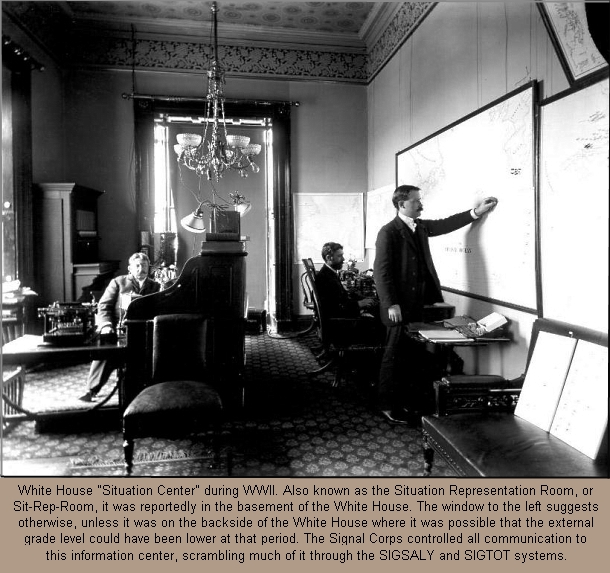 So what was the Signal Corps during WWII, and how
should it be thought of today? Perhaps the best way to answer that question is to
see it as
working to integrate every element of military communication and every user
of each form of communication, from the President (for whom the Signal Corps
provided communication links to the then called Situation Representation
Room in the basement of the White House), to the Secretary of War, the
Chiefs of Staff, the General and Special Staffs who ruled over theaters,
task forces, defense and base commands, the Army Ground, Air, and Service
Forces, all the way down to the subdivisions that controlled ground and air
arms and services. In other words, while at the beginning of WWII it might
not have started out so, by the end of the second world war the Signal Corps handled all of these and more.
Even today it looks, smells and tastes
much the same.
So what was the Signal Corps during WWII, and how
should it be thought of today? Perhaps the best way to answer that question is to
see it as
working to integrate every element of military communication and every user
of each form of communication, from the President (for whom the Signal Corps
provided communication links to the then called Situation Representation
Room in the basement of the White House), to the Secretary of War, the
Chiefs of Staff, the General and Special Staffs who ruled over theaters,
task forces, defense and base commands, the Army Ground, Air, and Service
Forces, all the way down to the subdivisions that controlled ground and air
arms and services. In other words, while at the beginning of WWII it might
not have started out so, by the end of the second world war the Signal Corps handled all of these and more.
Even today it looks, smells and tastes
much the same.
Today, in part because of its involvement in cyber
security and intelligence gathering and dissemination the Signal Corps
spends as much time managing key aspects of the multiplicity of army groups,
armies, corps, divisions, regiments, battalions, companies, and platoons
within which it has communication responsibilities as it does its own
functions. It also spends an inordinate amount of time thinking of the
future and planning for it, in terms of where communication is going and how
the Signal Corps can help the U.S. military achieve swift, strong,
adaptable, simple, and secure communication. Finally, it also spends a
sigificant amount of time liaising with sister agencies in the
various Air Force and Navy commands, sometimes down to the unusually
granular level of things such as Air Force wings, groups, squadrons, flights, administrative divisions, branches, sections, subsections, and on
and on.
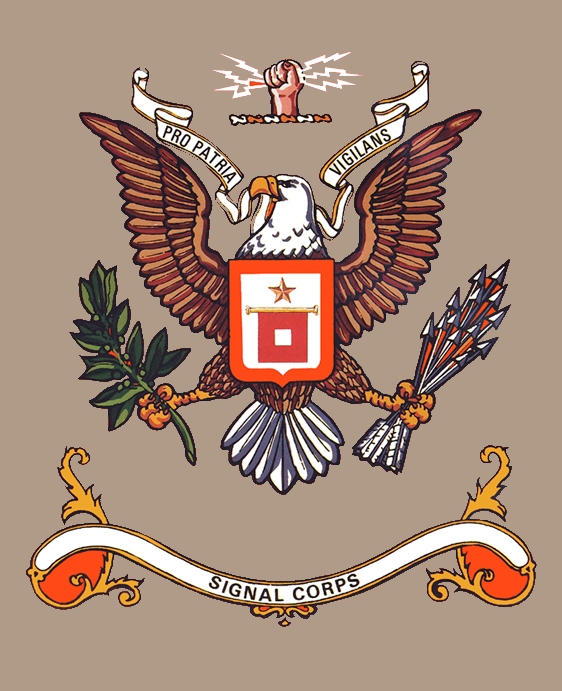 The point in all of this is that while originally the
thought was that the Signal Corps should be little more than an arm of the
combat service it
actually needed to provide a service akin to an overarching arm of the DoD
itself. The work the Signal Corps did during WWII began a movement in this
direction, with that movement accelerating throughout the Korean and Vietnam
Wars until today. In modern corporate
speak, since WWII it has been found that the Signal Corps needed to be
able to act as everything from the military's IT Department to its IS, CIS,
MIS, CS, and EE experts, providing both hardware, software, services, and management
expertise throughout all of the “customer facing” areas and interface points
the military has.
The point in all of this is that while originally the
thought was that the Signal Corps should be little more than an arm of the
combat service it
actually needed to provide a service akin to an overarching arm of the DoD
itself. The work the Signal Corps did during WWII began a movement in this
direction, with that movement accelerating throughout the Korean and Vietnam
Wars until today. In modern corporate
speak, since WWII it has been found that the Signal Corps needed to be
able to act as everything from the military's IT Department to its IS, CIS,
MIS, CS, and EE experts, providing both hardware, software, services, and management
expertise throughout all of the “customer facing” areas and interface points
the military has.
For those not familiar with the term "customer facing," it is worth a
moment to note what comprises the customer facing aspects of today's
military. In this context, customer facing means that area of the military that supports
and services the “stakeholders” that must be dealt with
in order to achieve the military's communication goals. Thus a customer
facing interface point marks that specific locus where Signal Corps
personnel and/or equipment come face to face with one of the Signal Corps'
stakeholders, as it attempts to meet that stakeholder's needs.
In terms of who these stakeholders are, flitting here
between the business world and the military world, we can say that such stakeholders extend far beyond
customers (in military speak, think: the citizens of the country you are fighting
for) to include shareholders (the people who provide the money you need in
order for you to do your job… e.g. Congress); to the employees (members of
the Signal Corps itself); third party customers (your allies in war); suppliers
(everyone from the Navy, Coast Guard or Air Force that may provide a service
to you or depend on a service you provide); to the companies that make your
equipment; the allied countries and militaries that help feed, clothe and
house you; communities (e.g. external parties that train your people,
provide protection [e.g. Blackwater]); commercial organizations (e.g. those
who assure that your equipment arrives on time); to all manner of remotely
associated entities from suppliers to third party governments and
regulatory agencies, legislative bodies, industry trade groups, professional
associations, NGOs, advocacy groups, prospective recruits, local
communities, the public at large, competitors, analysts and the media,
alumni, research centers, and of course the future generations whose life
and liberty Signal Corps efforts are trying to ensure. It's a long list,
these stakeholders whose needs the Signal Corps is trying to meet.
Finally, it should not be missed that because it has
integrated itself so completely throughout every aspect of the military's
operation, the U.S.
Army Signal Corps is homogonously the jugular of the military. If it gets cut, the war
effort stops. Signaling comprises an indisputable operational need; without
it the U.S. military's eyes and ears cease to be of value and its mind is
without substance to parse.
Which brings us to our conclusion, as a nation we owe a
debt of gratitude to those rare military leaders of WWII who recognized the
need for the
Signal Corps to embark on a major transition, moving the unit away from its
then traditional role towards one which would support the U.S. military well
into the 21st century and beyond. Single handedly they defined a set of new
responsibilities for the Signal Corps, tasks that took the Corps from a support arm with vague
capabilities and capacities developed during World War I to becoming a crucial part of the
WWII war
effort and every war since then.
Our debt of gratitude must also extend to
those WWII Signal Corps Officers who recognized the new role they needed to play, and
both re-dedicated and redoubled their own efforts towards assuring that the Signal Corps
acquired and mastered the capabilities it needed in order to meet the
nation's needs… from developing new forms of communication to managing
their supply to the field, training and staffing in their use, and assuring
that those who needed these systems most had ready, responsive and timely
access to them, along with well trained operators who could see to it that
these systems worked. If you want to know the names of these Officers,
you'll find the bulk of them listed
here. We salute them all.
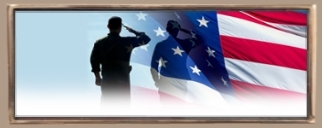


Footnotes
[1] For more information on Moore's Law, please click here
 )
- To
return to your place in the text click here:
)
- To
return to your place in the text click here:

[2] Radiosonde: a radio probe able to read barometric
pressure and other data at altitude and transmit it back to a fixed receiver
on the ground. Today radiosondes measure pressure, altitude, geographical
position (latitude and longitude), temperature, relative humidity, wind
speed, wind direction, and cosmic ray levels. Radiosondes that measure ozone
concentrations are known as ozonesondes.
- To
return to your place in the text click here:

[3] The Army Ground Forces drew in the Infantry, Cavalry,
Field Artillery, Coast Artillery Corps, Armored Force, Antiaircraft Command,
and Tank Destroyer Command. - To
return to your place in the text click here:

Additional Sources
Thompson, R.L. (1947). Wiring a continent: A history of the telegraph
industry in the USA, 1832-1886. Princeton, NJ: Princeton University
Press.
Rivise, M.J. (1950). Inside Western Union. New York: Sterling
Publishing Company.
WD, Introduction to Employment in the War Department—A Reference Manual
for Employees, Aug 1942, p. 21.
- - - -
Have a comment on this article? Send it to us. If you
are a member of the Association we will gladly publish it. If you are not,
well, it only costs $30.00 a year to become a member and have your views
heard... and because we are a fully compliant non-profit organization your
payment is tax deductable. If you would rather not become a member a $30.00
donation to our
Scholarship Fund will accomplish the same, and we
will gladly publish your views on this article.

